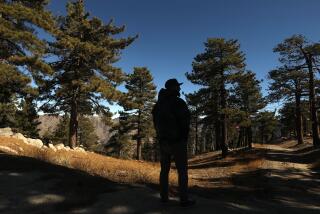Soka Debate May Hurt Funding
- Share via
WASHINGTON — In an annual ritual, Rep. Anthony C. Beilenson (D-Woodland Hills) asked a House subcommittee Thursday for $20 million in the 1994 fiscal year to buy additional parkland in the Santa Monica Mountains.
But this year’s request may face additional obstacles because of the escalating struggle over Soka University’s scenic mountain campus that has spilled into the halls of Congress and the upper reaches of the Clinton Administration.
Soka and its lobbyists are trying to persuade lawmakers on the House and Senate appropriations committees to include language in the 1994 interior spending bill stipulating that no federal money will be used in proceedings to condemn any of its coveted property. They also met with Interior Secretary Bruce Babbitt last month.
The Santa Monica Mountains Conservancy, a state agency that buys and manages land for the national recreation area, has begun the condemnation process to obtain almost half the school’s property in a meadow south of Calabasas for a visitors center and park headquarters. Soka officials, who want to expand the campus into a liberal arts college, refused the conservancy’s $19.7-million offer for 244 acres last year and are fighting the takeover effort in court.
Proponents of the Santa Monica National Recreation Area maintain that Soka’s anti-condemnation lobbying has made it more difficult for them to secure funds through the intensely competitive congressional appropriations process.
Shortly after testifying before the House Appropriations interior subcommittee, Beilenson bristled when pressed about Soka.
“It’s clear they are attacking the park itself,” said Beilenson, who sponsored the 1978 bill that created the recreation area. “They’re doing their utmost to succeed in preventing additional appropriations for the park. I think it’s clear they are anti-park people.”
Beilenson declined to say whether he would oppose the insertion of anti-condemnation language in the appropriations bill, although he has done so in the past.
Soka officials and their Los Angeles lobbyist, Joe Cerrell, have made two trips to the capital in recent months to meet with lawmakers, staff and Babbitt to press their case, said university spokesman Jeff Ourvan. They were joined by lobbyists from the Washington firm of O’Connor & Hannan, whose many clients include the governments of Israel and El Salvador.
Ourvan said that their goal was to inform federal officials about Soka--which sponsors English and foreign language classes and a research center and is partially funded by the Japanese branch of Soka Gakkai, a Buddhist lay organization. He said they also made the officials aware of an offer Soka has made to donate a portion of its campus to the park and to build a visitors center and park headquarters. Park authorities have rejected the proposal.
And, Ourvan acknowledged, Soka representatives asked for a provision in the 1994 Interior spending bill that would prohibit the use of federal funds to use condemnation to acquire property. Condemnation allows the government to obtain land from an unwilling seller for a court-established fair market price.
He said that the brief April 26 meeting with Babbitt, which was arranged by lobbyist Patrick O’Connor, was “to let him know about the joint-use proposal” to donate land to the park and proceed with the campus expansion. Ourvan said that Babbitt “did not offer a response at the time and the university has not heard from him since.” Jay Ziegler, a spokesman for Babbitt, said that the secretary “is very interested in this issue,” but declined further comment.
Ourvan denied Beilenson’s assertion that the Soka officials have attacked the park itself.
“We are in no way opposed to funding for the Santa Monica Mountains National Recreation Area,” Ourvan said. “We think the acquisition of open space is important. We just do not want our property to be sold. There are a lot of willing sellers out there.”
Two years ago, Soka got the Senate Appropriations Committee to insert anti-condemnation language into its spending bill, which was later removed. Last year, Sen. Harry Reid (D-Nev.), a park proponent who sits on the Senate Appropriations interior subcommittee, assured Republican colleagues that none of the 1993 money would be used for condemnation.
Ourvan said that is not what happened. “We’re under the impression that a portion of the money was set aside for condemnation,” he said. “The money must have originated from federal allocations that were transferred to the Conservancy’s coffers.”
Beilenson said he believed that none of the $13.2 million that the Santa Monicas received last year went to the conservancy’s condemnation fund and that none of the new money would either. Joseph T. Edmiston, the Conservancy’s executive director, could not be reached for comment.
Beilenson said he was requesting $20 million or more to buy “at least one major property and perhaps several smaller properties.”
Among the priority parcels that Beilenson mentioned were the Paramount Ranch; Zuma and Tracas canyons; the Backbone Trail; Upper Topanga Canyon; Palo Comado Canyon; China Flat and Corral Canyon. The specific use of the funds will be determined, in part, by whether a complex $29.5-million deal involving entertainer Bob Hope and the Ahmanson Ranch is culminated.
More to Read
Sign up for Essential California
The most important California stories and recommendations in your inbox every morning.
You may occasionally receive promotional content from the Los Angeles Times.










